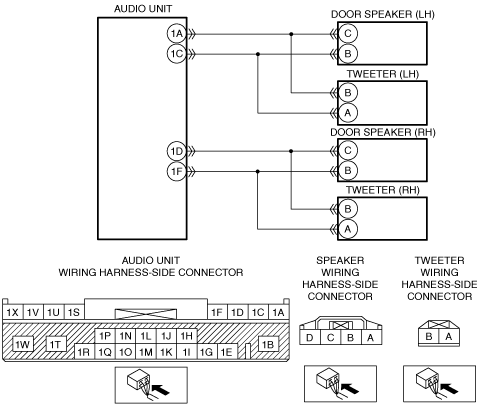|
1
|
VERIFY MALFUNCTION SYMPTOM
• The ignition is switched to ACC or ON (engine off or on).
• Launch the “Speaker Inspection” of the on-board diagnostic assist function.
• Is sound output from each speaker?
|
Yes
|
• System is normal.
• Due to the possibility that sound is not output in some modes, verify the malfunction in the symptom troubleshooting chart and perform the other applicable malfunction diagnosis.
|
|
No
|
No sound is produced from all speakers
• Go to the next step.
No sound is produced from some speakers
• Go to Step 3.
|
|
2
|
INSPECT AUDIO UNIT CONNECTOR
• Switch the ignition off.
• Disconnect the negative battery terminal.
• Disconnect the audio unit connector.
• Inspect the connector engagement and connection condition and inspect the terminals for damage, deformation, corrosion, or disconnection.
• Is the connector normal?
|
Yes
|
Replace the audio unit, then go to Step 7.
|
|
No
|
Repair or replace the connector, then go to Step 7.
|
|
3
|
INSPECT SPEAKER AND TWEETER CONNECTIONS
• Switch the ignition off.
• Disconnect the negative battery terminal.
• Disconnect the connector of the speaker or tweeter which is malfunctioning.
• Inspect the connector engagement and connection condition and inspect the terminals for damage, deformation, corrosion, or disconnection.
• Is the connector normal?
|
Yes
|
Go to the next step.
|
|
No
|
Repair or replace the connector, then go to Step 7.
|
|
4
|
SPEAKER OR TWEETER INSPECTION
• Inspect the malfunctioning speaker or tweeter.
• Is the speaker or tweeter resistance normal?
|
Yes
|
Go to the next step.
|
|
No
|
Replace the malfunctioning speaker or tweeter, then go to Step 7.
|
|
5
|
INSPECT SPEAKER CIRCUIT FOR OPEN CIRCUIT
• Disconnect the malfunctioning speaker or tweeter and the audio unit connector.
• Verify the continuity of the wiring harness between the following terminals (vehicle wiring harness side) of the speaker or tweeter which are malfunctioning.
-
― Audio unit terminal 1A and door speaker (LH) terminal C
― Audio unit terminal 1A and tweeter (LH) terminal B
― Audio unit terminal 1C and door speaker (LH) terminal B
― Audio unit terminal 1C and tweeter (LH) terminal A
― Audio unit terminal 1D and door speaker (RH) terminal C
― Audio unit terminal 1D and tweeter (RH) terminal B
― Audio unit terminal 1F and door speaker (RH) terminal B
― Audio unit terminal 1F and tweeter (RH) terminal A
• Is there continuity?
|
Yes
|
Go to the next step.
|
|
No
|
• Refer to the wiring diagram and verify if there is a common connector between the following terminals.
-
― Audio unit terminal 1A and door speaker (LH) terminal C
― Audio unit terminal 1A and tweeter (LH) terminal B
― Audio unit terminal 1C and door speaker (LH) terminal B
― Audio unit terminal 1C and tweeter (LH) terminal A
― Audio unit terminal 1D and door speaker (RH) terminal C
― Audio unit terminal 1D and tweeter (RH) terminal B
― Audio unit terminal 1F and door speaker (RH) terminal B
― Audio unit terminal 1F and tweeter (RH) terminal A
If there is a common connector:
-
― Inspect the common connector and terminals for corrosion, damage, or disconnection and the common wiring harnesses for an open circuit to determine the malfunctioning location.
― Repair or replace the malfunctioning location.
If there is no common connector:
-
― Repair or replace the wiring harness which has an open circuit.
• Go to Step 7.
|
|
6
|
INSPECT SPEAKER CIRCUIT FOR SHORT TO GROUND
• Verify that the connector of the malfunctioning speaker or tweeter and the audio unit connector are disconnected.
• Inspect for continuity between the following terminals (vehicle wiring harness side) of the speaker or tweeter which are malfunctioning and body ground.
-
― Door speaker (LH) terminal C
― Door speaker (RH) terminal C
― Tweeter (LH) terminal B
― Tweeter (RH) terminal B
• Is there continuity?
|
Yes
|
• Refer to the wiring diagram and verify if there is a common connector between the following terminals.
-
― Audio unit terminal 1A and door speaker (LH) terminal C
― Audio unit terminal 1A and tweeter (LH) terminal B
― Audio unit terminal 1D and door speaker (RH) terminal C
― Audio unit terminal 1D and tweeter (RH) terminal B
If there is a common connector:
-
― Inspect the common connector and terminals for corrosion, damage, or disconnection and the common wiring harnesses for short to ground to determine the malfunctioning location.
― Repair or replace the malfunctioning location.
If there is no common connector:
-
― Repair or replace the wiring harness which is shorted to ground.
• Go to the next step.
|
|
No
|
Replace the audio unit, then go to the next step.
|
|
7
|
VERIFY IF MALFUNCTION CAUSE IS CORRECTED
• Connect all the connectors.
• Switch the ignition to ACC or ON (engine off or on).
• Launch the “Speaker Inspection” of the on-board diagnostic assist function.
• Is sound output from each speaker?
|
Yes
|
Troubleshooting completed. (explain the contents of the servicing to the customer)
|
|
No
|
Verify the malfunction symptom in the symptom troubleshooting chart and perform the other applicable malfunction diagnosis.
|
